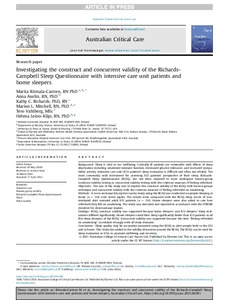Investigating the construct and concurrent validity of the Richards-Campbell Sleep Questionnaire with intensive care unit patients and home sleepers
Leino-Kilpi Helena; Vahlberg Tero; Axelin Anna; Mitchell Marion L; Ritmala-Castren Marita; Richards Kathy C
Investigating the construct and concurrent validity of the Richards-Campbell Sleep Questionnaire with intensive care unit patients and home sleepers
Leino-Kilpi Helena
Vahlberg Tero
Axelin Anna
Mitchell Marion L
Ritmala-Castren Marita
Richards Kathy C
The Confederation
Julkaisun pysyvä osoite on:
https://urn.fi/URN:NBN:fi-fe2021093048667
https://urn.fi/URN:NBN:fi-fe2021093048667
Tiivistelmä
BACKROUND: Sleep is vital to our wellbeing. Critically ill patients are vulnerable with effects of sleep deprivation including weakened immune function, decreased glucose tolerance, and increased sympathetic activity. Intensive care unit (ICU) patients' sleep evaluation is difficult and often not reliable. The most commonly used instrument for assessing ICU patients' perspective of their sleep, Richards-Campbell Sleep Questionnaire (RCSQ), has not been reported to have undergone known-group construct validity testing or concurrent validity testing with the criterion measure of feeling refreshed.
OBJECTIVES: The aim of the study was to explore the construct validity of the RCSQ with known-groups technique and concurrent validity with the criterion measure of feeling refreshed on awakening.
METHODS: A cross-sectional descriptive survey study using the RCSQ was conducted on people sleeping at home (n = 114) over seven nights. The results were compared with the RCSQ sleep scores of nonintubated alert oriented adult ICU patients (n = 114). Home sleepers were also asked to rate how refreshed they felt on awakening. The study was executed and reported in accordance with the STROBE checklist for observational studies.
FINDINGS: RCSQ construct validity was supported because home sleepers' and ICU sleepers' sleep evaluations differed significantly. Home sleepers rated their sleep significantly better than ICU patients in all five sleep domains of the RCSQ. Concurrent validity was supported because the item "feeling refreshed on awakening" correlated strongly with all sleep domains.
CONCLUSIONS: Sleep quality may be accurately measured using the RCSQ in alert people both in the ICU and at home. This study has added to the validity discussion around the RCSQ. The RCSQ can be used for sleep evaluation in ICUs to promote wellbeing and recovery.
Kokoelmat
- Rinnakkaistallenteet [19249]
